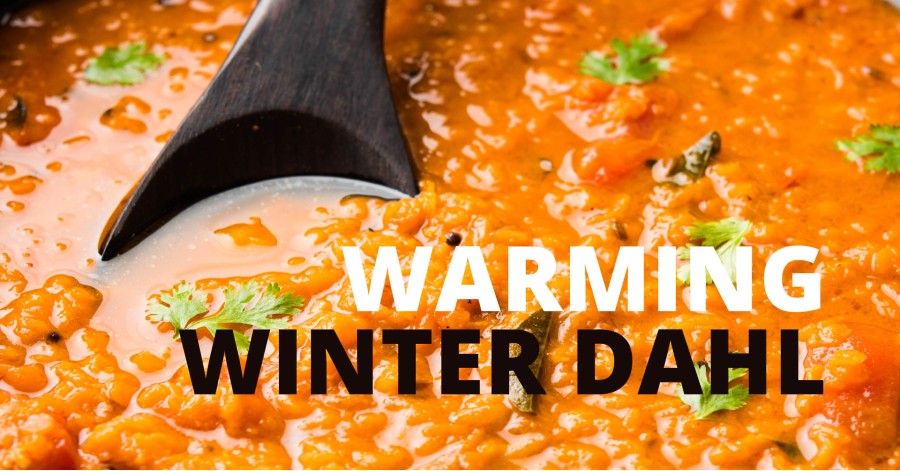
Warming Winter Dahl Recipe
- Warming Winter Dahl
- 5 cloves of garlic
- 2-inch chunk of ginger (crushed or finely diced)
- 6 spring onions
- 10 cherry tomatoes
- 1 tin of chickpeas
- 150g red dry lentils
- 2 handfuls of spinach (fresh or frozen)
- 1 tin of organic coconut milk
- A fresh lime
- Coriander
- 2 tbsp curry powder
- 2 tsp garam masala
- 1 tsp cumin seeds
- 1 tsp coriander seeds
- 1 tsp chili flakes or (optional)
- Salt and pepper
- Rinse lentils and place in boiling water, bring to the boil and let simmer for about 15 minutes.
- Rinse chickpeas and leave to soak.
- Chop vegetables and chop a half handful of coriander.
- Heat oil in a large pot, add the garlic and ginger and cook for about 3 minutes.
- Add the spring onions, coriander and a pinch of salt and cook for 5 minutes.
- Add tomatoes to the pan and as they soften roughly mash them down.
- Add the organic coconut milk, chickpeas and lentils and mix well.
- Add in the salt, pepper and spices. Bring to the boil and let simmer for 25 minutes.
- Add the spinach and let cook for another 5 minutes.
- Serve in a bowl with a sprig of coriander on top, and a wedge of lime to be squeezed over. Perfect alone or accompanied by brown rice or pitta bread.
This warming winter dahl contains everything you need to keep you warm and nourished during the winter months. With its combination of nutritious plant-based proteins, light vegetables and warm spices, this meal is the perfect antidote to a cold winter’s evening.
Let’s take a look at the nutritional benefits this dish has to offer.
1. Spices
- Ginger is one of nature’s most powerful anti-inflammatories and has shown to be a potent natural pain reliever (1). Studies also show that ginger can play a supportive role in weight loss. A recent review explained that ginger may reduce body weight, waist-hip ratios, and hip ratios in people who are overweight or obese (2).
- Garlic is sometimes referred to as a spice and other times a vegetable. Thanks to the allicin in garlic, this ingredient should be used a lot in the lead up to and during winter months to help keep colds and flu at bay. Garlic is well-known for its powers in combating the common cold and also has natural blood pressure lowering properties with studies showing significant reductions in those with high blood pressure (5)(6). You can obtain the benefits of garlic by eating it raw or cooked. Aim for a combination of both throughout the day; just don’t forget your toothbrush if you have a post-garlicky-lunch meeting!
- Cumin has been used for many years in traditional medicine. It is most commonly used to support the digestive system, with numerous studies showing that cumin can speed up digestion (7)(8). Cumin also boasts antimicrobial properties and can lower the risk of food-borne infections (9).
2. Fruits and vegetables
- Spinach is a nutrient-dense leafy green that originates from the Middle East. It is a great source of vitamins and minerals such as vitamin A, vitamin C, vitamin K1 and folic acid. Spinach does contain a solid amount of iron and calcium, but unfortunately it is not very bioavailable (possible to absorb). Spinach offers eye health benefits as it contains lutein and zeaxanthin: studies suggest these properties may help protect the eyes from damage caused by sunlight (10).
- Cherry tomatoes are fruits that are used like vegetables. The lycopene in tomatoes has been shown to have a protective effect against sunburn and harmful UV radiation (11)(12). While the evidence is not yet conclusive, some interesting observational studies have noted a link between tomato and tomato-based products and fewer incidences of stomach, lung and prostate cancer (13)(14)
3. Plant-based proteins
- Chickpeas are a deliciously nutritious legume that can be used in everything from hummus to curries, and from burgers to cookie dough. First and foremost, chickpeas are rich in plant-based proteins, with 28 grams offering 3 grams of protein. Chickpeas have a low glycemic load and may play a role in blood sugar management (15). Their high fibre content further supports effective blood sugar management (16). Chickpeas may also help to reduce your risk of certain cancers. In particular, regular chickpea consumption may promote the body’s production of butyrate which may reduce inflammation in colon cells, potentially reducing the risk of colon cancer (17).
- Lentils come in many colours, with the most common being red or green. Containing zinc, iron, copper, potassium, magnesium, folate, fibre and protein, they are a highly nutritious and inexpensive way of obtaining nutrients. The fibre in lentils may help to support regular bowel movements and the growth of healthy gut bacteria, therefore improving your overall gut function (18). Lentils also contain a range of beneficial plant compounds called phytochemicals, many of which have been shown to protect against chronic diseases such as heart disease and type 2 diabetes (19).
This dish is tasty, healthy, inexpensive and, as mentioned, ranks highly on the nutritional scale. One try is all you will need for this to become a staple dish in your household. Enjoy!
References:
1. Black, CD., Herring, Mp., Hurley, Dj. and O’ Connor, Pj. (2010). Ginger (Zingiber Officinale) Reduces Muscle Pain Caused by Eccentric Exercise. [online] The journal of pain : official journal of the American Pain Society. Available at: https://pubmed.ncbi.nlm.nih.gov/20418184/ [Accessed 17 Oct. 2020]
2. Maharlouei, N., Tabrizi, R., Lankarani, K.B., Rezaianzadeh, A., Akbari, M., Kolahdooz, F., Rahimi, M., Keneshlou, F. and Asemi, Z. (2018). The effects of ginger intake on weight loss and metabolic profiles among overweight and obese subjects: A systematic review and meta-analysis of randomized controlled trials. Critical Reviews in Food Science and Nutrition, [online] 59(11), pp.1753–1766. Available at: https://pubmed.ncbi.nlm.nih.gov/29393665/ [Accessed 18 Oct. 2020]
3. P, Josling (2001). Preventing the Common Cold With a Garlic Supplement: A Double-Blind, Placebo-Controlled Survey. [online] Advances in therapy. Available at: https://pubmed.ncbi.nlm.nih.gov/11697022/ [Accessed 17 Oct. 2020]
4. Nantz, M.P., Rowe, C.A., Muller, C.E., Creasy, R.A., Stanilka, J.M. and Percival, S.S. (2012). Supplementation with aged garlic extract improves both NK and γδ-T cell function and reduces the severity of cold and flu symptoms: a randomized, double-blind, placebo-controlled nutrition intervention. Clinical Nutrition (Edinburgh, Scotland), [online] 31(3), pp.337–344. Available at: https://www.ncbi.nlm.nih.gov/pubmed/22280901 [Accessed 18 Oct. 2020]
5. Sobenin, I.A., Andrianova, I.V., Demidova, O.N., Gorchakova, T. and Orekhov, A.N. (2008). Lipid-lowering effects of time-released garlic powder tablets in double-blinded placebo-controlled randomized study. Journal of atherosclerosis and thrombosis, [online] 15(6), pp.334–8. Available at: https://www.ncbi.nlm.nih.gov/pubmed/19060427/ [Accessed 19 Oct. 2020]
6. Ried, K., Frank, O.R. and Stocks, N.P. (2010). Aged garlic extract lowers blood pressure in patients with treated but uncontrolled hypertension: A randomised controlled trial. Maturitas, [online] 67(2), pp.144–150. Available at: https://pubmed.ncbi.nlm.nih.gov/20594781/ [Accessed 19 Oct. 2020]
7. Johri, R. (2011). Cuminum cyminum and Carum carvi: An update. Pharmacognosy Reviews, [online] 5(9), p.63. Available at: https://www.ncbi.nlm.nih.gov/pmc/articles/PMC3210012/ [Accessed 18 Oct. 2020]
8. Milan, K.S.M., Dholakia, H., Tiku, P.K. and Vishveshwaraiah, P. (2008). Enhancement of digestive enzymatic activity by cumin (Cuminum cyminum L.) and role of spent cumin as a bionutrient. Food Chemistry, [online] 110(3), pp.678–683. Available at: https://www.sciencedirect.com/science/article/pii/S0308814608002483 [Accessed 18 Oct. 2020]
9. Billing, J. and Sherman, P.W. (1998). Antimicrobial Functions of Spices: Why Some Like it Hot. The Quarterly Review of Biology, [online] 73(1), pp.3–49. Available at: https://www.jstor.org/stable/3036683?seq=1 [Accessed 21 Oct. 2020]
10. Roberts, R.L., Green, J. and Lewis, B. (2009). Lutein and zeaxanthin in eye and skin health. Clinics in Dermatology, [online] 27(2), pp.195–201. Available at: https://pubmed.ncbi.nlm.nih.gov/19168000/ [Accessed 18 Oct. 2020]
11. Stahl, W., Heinrich, U., Aust, O., Tronnier, H. and Sies, H. (2006). Lycopene-rich products and dietary photoprotection. Photochemical & Photobiological Sciences: Official Journal of the European Photochemistry Association and the European Society for Photobiology, [online] 5(2), pp.238–242. Available at: https://www.ncbi.nlm.nih.gov/pubmed/16465309 [Accessed 21 Oct. 2020]
12. Aust, O., Stahl, W., Sies, H., Tronnier, H. and Heinrich, U. (2005). Supplementation with tomato-based products increases lycopene, phytofluene, and phytoene levels in human serum and protects against UV-light-induced erythema. International Journal for Vitamin and Nutrition Research. Internationale Zeitschrift Fur Vitamin- Und Ernahrungsforschung. Journal International De Vitaminologie Et De Nutrition, [online] 75(1), pp.54–60. Available at: https://pubmed.ncbi.nlm.nih.gov/15830922/ [Accessed 21 Oct. 2020]
13. Giovannucci, E. (1999). Tomatoes, tomato-based products, lycopene, and cancer: review of the epidemiologic literature. Journal of the National Cancer Institute, [online] 91(4), pp.317–331. Available at: https://www.ncbi.nlm.nih.gov/pubmed/10050865 [Accessed 20 Oct. 2020]
14. Giovannucci, E. (2002). A Review of Epidemiologic Studies of Tomatoes, Lycopene, and Prostate Cancer. Experimental Biology and Medicine, [online] 227(10), pp.852–859. Available at: https://pubmed.ncbi.nlm.nih.gov/12424325/ [Accessed 20 Oct. 2020]
15. Wallace, T., Murray, R. and Zelman, K. (2016). The Nutritional Value and Health Benefits of Chickpeas and Hummus. Nutrients, [online] 8(12), p.766. Available at: https://www.ncbi.nlm.nih.gov/pmc/articles/PMC5188421/ [Accessed 20 Oct. 2020]
16. Lattimer, J.M. and Haub, M.D. (2010). Effects of Dietary Fiber and Its Components on Metabolic Health. Nutrients, [online] 2(12), pp.1266–1289. Available at: https://www.ncbi.nlm.nih.gov/pmc/articles/PMC3257631/ [Accessed 18 Oct. 2020]
17. Fernando, W., Hill, J., Zello, G., Tyler, R., Dahl, W. and Van Kessel, A. (2010). Diets supplemented with chickpea or its main oligosaccharide component raffinose modify faecal microbial composition in healthy adults. Beneficial Microbes, [online] 1(2), pp.197–207. Available at: https://pubmed.ncbi.nlm.nih.gov/21831757/ [Accessed 19 Oct. 2020]
18. Stephen, A.M., Dahl, W.J., Sieber, G.M., van Blaricom, J.A. and Morgan, D.R. (1995). Effect of green lentils on colonic function, nitrogen balance, and serum lipids in healthy human subjects. The American Journal of Clinical Nutrition, [online] 62(6), pp.1261–1267. Available at: https://pubmed.ncbi.nlm.nih.gov/7491890/ [Accessed 20 Oct. 2020]
19. Ganesan, K. and Xu, B. (2017). Polyphenol-Rich Lentils and Their Health Promoting Effects. International Journal of Molecular Sciences, [online] 18(11), p.2390. Available at: https://www.ncbi.nlm.nih.gov/pmc/articles/PMC5713359/ [Accessed 18 Oct. 2020]


